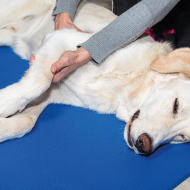More accurate technique for understanding joint behaviour

"I hope our method will contribute to uncovering the secrets of osteoarthritis in the future" - Dr Kamel Madi.
Scientists have discovered a new technique for understanding joint behaviour in conditions like osteoarthritis with more accuracy than ever before.
The groundbreaking technique, published in Nature Research, employs high-resolution imaging and specially-designed software code to gain a deeper understanding of how joints react as osteoarthritis progresses.
Joint strain is traditionally measured on the nanometer scale on tissue structures such as collagen fibres, chondrocyte cells and bones.
Until now, such strains have only been measured at the sub-millimetre scale in whole joints during loading. In this study, scientists measured these strains in mouse knee joints with an accuracy greater than 100 nanometers - 1,000 times more precise than before.
The study involved male ‘STR/Ort’ mice, which develop a natural form of osteoarthritis with age, similar to the human disease. The researchers then compared these mice with male age-matched control mice that did not display any signs of age-related osteoarthritis.
It used combination of x-ray tomography, a nano-precision loading frame and a software code designed to measure motion between subsequent 3D images with a resolution of 1/20th of a voxel (3D pixel).
Researchers found that in young, older and arthritic mice, changes in tissue structure and mechanical behaviour can be simultaneously visualised, and that tissue structure at the cellular level is comparative with the mechanical performance of the joint as a whole.
The collaborative study was conducted by researchers from the Royal Veterinary College (RVC), Edinburgh Napier University, University College London, Oregon State University (US), 3Dmagination and the Diamond Light Source.
RVC skeletal dynamics professor Andrew A Pitsillides, explained: “Our technique for nanometre scale measurement of real deformation in whole joints under conditions closely mimicking their normal use will, I hope, bring new understanding of joint behaviour in health and in osteoarthritis that devastates the lives of so many.”
3Dmagination Ltd director Dr Kamel Madi, added: “Measuring precise and reliable nanoscale strains in this complex biomedical system requires a perfect blend of skills, from in situ imaging to reconstruction and quantification of several terabytes of dataset, which is the team’s expertise at 3Dmagination Ltd.
“I am also passionate about bringing the images to life and I hope our method will contribute to uncovering the secrets of osteoarthritis in the future.”



 The BSAVA has opened submissions for the BSAVA Clinical Research Abstracts 2026.
The BSAVA has opened submissions for the BSAVA Clinical Research Abstracts 2026.